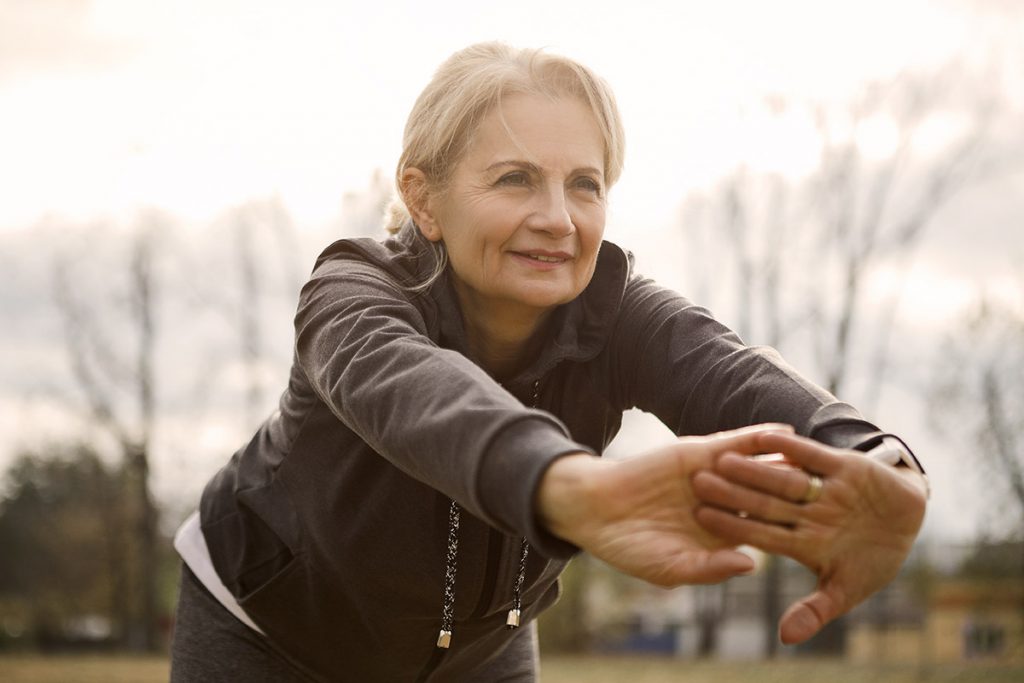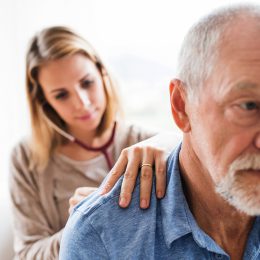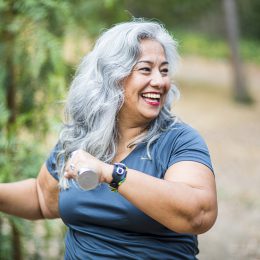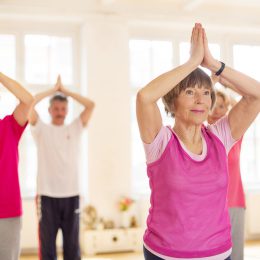What Is COPD? 12 Facts You Need to Know
Chronic obstructive pulmonary disease, or COPD, can sneak up on you. This guide will help you learn what to look for and what treatments are available.

Chronic obstructive pulmonary disease (COPD) is a lung condition that blocks the airways and makes it hard to breathe. More than 12 million people in the United States have been diagnosed with COPD. Millions more people may have it and just don’t know it yet.
It’s common to think that the symptoms of COPD, like shortness of breath and fatigue, are normal signs of aging. Because of this, the disease may have grown serious by the time someone goes to a doctor to discuss their symptoms.
If you’re a smoker, you’re especially at risk. Cigarettes are the main cause of COPD. Whether you use cigarettes or not, there are ways to help preserve your lung health and start breathing easier.
Add SilverSneakers to your wellness routine! Classes and events are happening daily at participating gyms, online through SilverSneakers LIVE, and at community centers near you. Activate your free online account to get started.
What is COPD?
COPD is a group of lung diseases that make it hard to breathe. There are two main types: emphysema and chronic bronchitis. Most people with COPD will have both.
Emphysema is a condition where the air sacs in the lungs are damaged. The airways in healthy lungs are lined with stretchy, elastic air sacs that fill with air every time we breathe in. When we breathe out, the air sacs deflate. If you have emphysema, the air sacs can’t fill up with air as well.
Chronic bronchitis happens when the bronchial tubes become inflamed and irritated. Those are the airways that move air to and from the air sacs in your lungs. Chronic bronchitis causes mucus to build up, so it’s harder for your lungs to work properly.
Some people might have more symptoms of emphysema. Others might have more signs of bronchitis, says Javier Barreda Garcia, M.D. He is a pulmonologist with UTHealth Houston.
What are the symptoms of COPD?
The symptoms of COPD can develop slowly, but they tend to get worse over time. They include:
- Frequent coughing or wheezing
- Difficulty breathing
- A whistling when you breathe
- Shortness of breath (dyspnea)
- Chest tightness
- Excess phlegm or mucus
In more severe cases, COPD can cause:
- Weight loss
- Lower muscle weakness
- Swelling in the ankles, feet or legs
Some people who have COPD will also be more likely to catch respiratory infections like colds and the flu.
Recommended reading: 5 Early Signs of COPD Every Older Adult Should Know
What causes COPD?
COPD is often caused by long-term exposure to irritants that damage your lungs and airways. Cigarette smoking is by far the biggest cause of the disease. It is responsible for about 85 to 90 percent of all COPD cases, according to the American Lung Association.
The toxins in cigarette smoke can damage air sacs and cause the air tubes to swell. Secondhand smoke can also cause COPD.
It’s known that cigarettes cause COPD, but there isn’t enough research yet to know if vaping has the same risk, says Dr. Barreda Garcia. But the mixture of chemicals in e-cigarettes can damage the lungs. One study found that using e-cigarettes was linked to an increased risk of respiratory diseases, including COPD and asthma.
COPD can also be caused by exposure to environmental irritants, like air pollution, chemical fumes and dust.
Is there a genetic risk for COPD?
Yes, but it is rare. Dr. Barreda Garcia says COPD is sometimes caused by a genetic condition called alpha-1 antitrypsin (AAT) deficiency. AAT is a protein that’s made by the body to help protect your lungs from damage. People without enough AAT are more susceptible to lung damage from cigarette smoke, pollution or other irritants.
The gene is inherited and tends to run in families. That’s why, if a person has AAT, their relatives should be tested for it too, says Dr. Barreda Garcia. If someone has an AAT deficiency, their COPD may appear at an earlier age.
What is a COPD flare-up?
Some people with COPD will have a period of a few days where they experience more intense symptoms. These are called flare-ups. “Wheezing is the most characteristic symptom, but they can cough more, and their phlegm becomes yellow or green,” says Dr. Barreda Garcia.
It’s key to try to prevent a flare-up from happening. Flare-ups can make overall lung function decline faster. They are often triggered by a bacterial or viral infection, says Dr. Barreda Garcia.
Other causes of a flare-up can include smoke or other environmental pollutants, being too active or feeling stressed or anxious.
What are the health concerns for COPD for older adults?
Besides breathing issues, COPD also increases the risk for other serious health problems. “It typically affects more than just the lungs,” says Dr. Barreda Garcia. Some of these conditions include:
- Cold and flu complications. People with COPD are more likely to develop infections after catching a respiratory virus, which can increase the risk for pneumonia.
- Heart disease. This disease increases the risk for heart attacks, heart failure, chest pain, blood clots and an irregular heartbeat. It can also cause high blood pressure.
- Osteoporosis. Breathing problems can lead to inactivity. This increases the risk for bone loss.
What are signs that I might have COPD?
The only early symptom of COPD may be shortness of breath. Other signs of COPD can be a lingering cough, wheezing or a lot of mucus production.
Sometimes there are no early signs of COPD at all. But that doesn’t mean your airways are healthy. “People might go without symptoms for years, but when they finally come to a doctor with a cough or shortness of breath, their lung function has likely been going down for several years,” he says.
If you smoke or think you could be at risk for COPD, talk to your doctor. The earlier this condition is detected, the sooner you can start treating it.
How is COPD diagnosed?
COPD is usually detected with a spirometry test. That measures how well your lungs are working. You blow all the air out of your lungs into a mouthpiece that’s connected to a spirometer machine.
The machine provides two numbers. The first is the amount of air you blow out in the first second of the test. That number is known as FEV1, short for forced expiratory volume. The second number is the amount of air you can blow out completely. It’s called FVC, short for forced vital capacity.
Those two numbers make up your FEV1/FVC ratio. It is usually given to you as a percentage. Doctors compare it to people of your age, sex and height.
A normal percentage is somewhere around 70 to 80 percent. If yours is lower than that, the numbers help show how much airflow is blocked. “Patients can be classified as having mild, moderate or severe disease,” says Dr. Barreda Garcia.
Can exercise help with COPD?
Absolutely! Exercise can help you breathe better, says Dr. Barreda Garcia. One study published in the European Respiratory Journal found that doing more low-intensity physical activity can lower the risk of hospitalization from COPD.
Exercise can help ease shortness of breath and fatigue, improve physical fitness and lower feelings of anxiety and depression in people who have COPD.
Even if exercise doesn’t fully restore your lung function, it does strengthen the muscles and heart. That keeps you stronger and more active and may help you feel less out of breath.
Recommended reading: The Dos and Don’ts of Exercising With COPD
Which other lifestyle habits can improve COPD symptoms?
Along with quitting smoking and exercising, eating a healthy diet can help. Cutting back on carbohydrates may also help you breathe easier.
Here’s why: Our bodies produce more carbon dioxide when we metabolize carbohydrates than when we eat protein or fat. COPD makes it harder for your lungs to remove carbon dioxide. Fat produces the least amount of carbon dioxide. So a lower-carb, higher-fat diet may improve breathing.
Eating enough protein can also help people with COPD, says Dr. Barreda Garcia. Eating enough protein can help your body retain the muscle tissue you have.
Besides healthy eating, you may want to join a support group for other people who have COPD. This can be either online or in person. Talking with others who relate to your situation can help you feel more confident about managing your condition.
Recommended FREE SilverSneakers On-Demand Class: Breathing Exercises for Seniors
How is COPD treated?
There’s no cure for COPD. But it is possible to slow down the progression of the disease and improve your symptoms. Some of the treatments include:
Smoking cessation. Kicking your cigarette habit is the most important thing you can do to improve symptoms. “If you stop smoking, it prevents further damage to the lungs,” says Dr. Barreda Garcia. You should avoid secondhand smoke too.
Ask your doctor about nicotine patches, lozenges or gum. You may also be a candidate for prescription nicotine. That can be a nasal spray or an inhaler.
Subscribe to our newsletter
It's quick and easy. You could be one of the 13 million people who are eligible.
Already a member? Click to discover our 15,000+ participating locations.
Follow Us
Pulmonary rehabilitation. This is a rehab program that includes social support, education and exercise. It’s often one of the first treatments your doctor may recommend. A team of experts may be involved with your pulmonary rehabilitation. They include doctors, nurses, physical and respiratory therapists, exercise specialists and dietitians.
They will teach you breathing exercises that help boost your oxygen levels. You’ll also learn how to safely breathe during exercise. Pulmonary rehabilitation “is one of the most effective interventions to improve symptoms,” says Dr. Barreda Garcia. “It helps patients feel more energetic and it prevents COPD flare ups.”
Medication. Drugs called bronchodilators help relax and open the muscles around the airways. They make it easier to breathe. Bronchodilators are usually taken with an inhaler or a nebulizer. A nebulizer is a machine that turns the medication into a spray that goes directly into your lungs.
There are two kinds of bronchodilators: beta2-agonists and anticholinergics. Both come in short-acting and long-acting forms. The short-acting type relieves symptoms quickly. But the effects wear off quickly too. Long-acting bronchodilators help prevent breathing problems over the long term, but it takes longer for them to work.
Corticosteroids are another type of medication. These are a type of steroids that are usually delivered with an inhaler. They decrease swelling and mucus production and make it easier to breathe.
Corticosteroids are usually prescribed for a short period of time when your symptoms are flaring up. They can have serious side effects, like osteoporosis, weight gain and high blood sugar.
Doctors may also prescribe a combination of all three medications. It’s also smart to get a flu shot every year to reduce your risk for pneumonia.
Oxygen therapy. If your oxygen levels are low, your doctor may prescribe supplemental oxygen. You may need this all the time or only occasionally, like when you sleep. This extra oxygen can help you stay active, sleep better and have more energy.
Oxygen is usually delivered through nasal prongs or a face mask. Your doctor will set your oxygen flow rate, which is the number of liters of oxygen flowering each minute.
Endobronchial valve (EBV) therapy. Some people with advanced COPD and emphysema may qualify for a nonsurgical procedure called EBV therapy.
During this procedure, a doctor will insert valves into certain areas of the lungs using a small tube. It takes about an hour. Most people will need to stay in the hospital for a few days afterward.
Breathing typically improves after two to three weeks after this procedure. You must be willing to quit smoking or have already quit to be eligible for it.
Is surgery also an option?
Yes. There are two types of lung surgery for people with COPD. The first is a bullectomy. That’s when doctors surgically remove large, damaged air sacs in the lungs that can prevent you from breathing easily.
The other type of surgery is called lung volume reduction surgery (LVRS). This removes about 30 percent of the most diseased tissue in the lung. This helps the remaining tissues work more efficiently.
Not everyone with COPD will be able to have surgery. Patients must be strong enough to undergo the procedure, participate in a pulmonary rehabilitation program, and no longer smoke.
If the damage to the lungs is severe enough, you may be a candidate for a lung transplant. All major surgeries like this carry risks of course, and there’s also a chance of organ rejection.
See our sources:
COPD causes and risk factors: American Lung Association
COPD basics: American Lung Association
How is COPD diagnosed: COPD Foundation
Exercise and COPD: European Respiratory Journal
Check Your SilverSneakers Eligibility Instantly
SilverSneakers members can go to thousands of nationwide gyms and fitness locations, plus take SilverSneakers LIVE online classes that are designed for all fitness levels and abilities. If you have a Medicare Advantage plan, it may include SilverSneakers — at no additional cost. Check your eligibility instantly here.
Already a member? Get your SilverSneakers member ID and exclusive fitness and wellness content by activating your online account here.
Not eligible for SilverSneakers? You can still get 200+ free SilverSneakers On-Demand videos and stay in touch with us by creating your online account.





